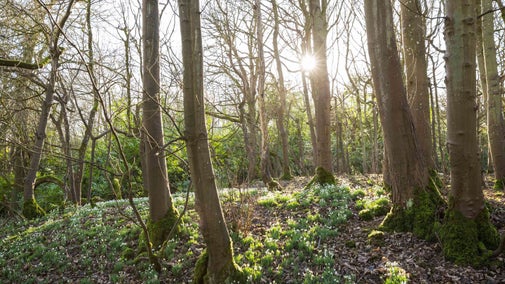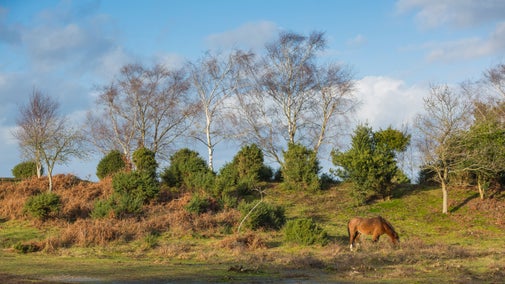
Discover more at Ludshott Common
Find out how to get to Ludshott Common, where to park, the things to see and do and more.

The heathland at Ludshott Common dates back 5,000 years and contains some of the few remaining areas of lowland heath in Europe. Discover some of the birdlife and wildlife you can see here, as well as similar heathlands and woodlands you can visit nearby.
Heathland is a haven for some of Britain’s rarest wildlife, supporting the majority of the UK populations of nightjars, dartford warblers and woodlarks. These birds nest either on the ground or in low growing vegetation and are vulnerable to disturbance. In early spring, listen out for the woodlark’s song, arguably one of the most beautiful in the country. Other bird species use heathland on their migration or winter routes, such as ring ouzels and hen harriers. Stonechats are common year-round inhabitants of heathland.
Heathlands are the most important habitat in the UK for our native reptiles, supporting all six species including grass snakes, smooth snakes, adders and sand lizards. Heathlands with a good mosaic of vegetation types provide warm, open areas for basking, an abundance of prey and longer vegetation for shelter from predators and extremes of temperature.
Other species to look out for include the green tiger beetle, day-flying emperor moth and silver-studded blue butterflies in the summer. You can also find mammals such as rabbits, hares, weasels, stoats and deer roaming the heath.
These species all have specific habitat requirements – a mix of tall bushy heather, scattered trees, clumps of gorse and bare sandy patches and can therefore only survive on carefully managed heathland.

Heathland is characterised by plants that love low-nutrient, well-drained sandy soils such as heather, bilberry, gorse and bracken.
In the spring, yellow gorse blooms are most abundant, whilst ling and bell heathers create pretty purple carpets in late summer.
Open heaths are characterised by their lack of trees, however scots pine, silver birch, oak and rowan can be found here.
In order for these species to survive, the heath is managed so that it provides the necessary mosaic of habitat.
Some woodland is retained to provide a habitat for birds like the redstart, wood warbler and goshawk.

The three ponds at Waggoners Wells in East Hampshire are popular as a cool shady retreat in summer and for the spectacular yellows and golds of the beech trees in autumn.
The ponds are thought to have been created in the 17th century as hammer ponds for the iron industry. The old trees around it are also important for lichens – 90 different types have been found here.
Near the ford is a memorial stone to Robert Hunter, one of the founders of the National Trust. He was involved with the acquisition of Ludshott Common in 1908, and Waggoners Wells was purchased in 1919 in his memory.
An ancient woodland that dates back to medieval times, Gentle’s Copse is comprised of coppiced sessile oaks, a tree that is rare in the south of the country. In the past, its wood was used for fuel and to make charcoal for the iron industry.
You can still see a stone-faced boundary bank that once prevented the commoners’ animals from straying into the copse.
Although a much smaller area at 16 hectares, Bramshott Chase is similar to Ludshott Common, as it's a mixture of heathland and secondary woodland.
Where to find Bramshott Chase
Lying half a mile to the north-west of Ludshott, the Chase forms part of Bramshott Common, which is a much larger area of heathland and scrub owned and managed by the Ministry of Defence.
It contributes an additional area of habitat supporting the same bird species as Ludshott.
Grazing cattle on the chase
Common rights still apply to the chase and there is periodic grazing by cattle owned by one of the commoners. This continues a long tradition and helps keep the site in a favourable condition for a number of heathland species.
The grazing also helps reduce the need for mechanical management.

Find out how to get to Ludshott Common, where to park, the things to see and do and more.
Everything you need to know to ensure you have a safe and enjoyable visit with your dog, including which times of year the law says they must be kept on a lead.

Find out how we're restoring heathland habitats and protecting wildlife, including the reintroduction of grazing cattle here.
Find out where you can go mountain biking at Black Down, Woolbeding Common, Ludshott Common and Hindhead Common and the Devil’s Punch Bowl, while protecting these habitats.

Plan a visit to one of the special countryside places in our care and discover the benefits of being in the great outdoors. Pack your walking boots and get ready to explore woodlands, valleys and rivers.

Explore some of the finest landscapes in our care on coastal paths, accessible trails, woodland walks and everything in between. Find the best places to walk near you.

Enjoy the varied landscapes around Hampshire, from the huge expanses of New Forest common to the wildlife-rich downland and marshes of Stockbridge.
